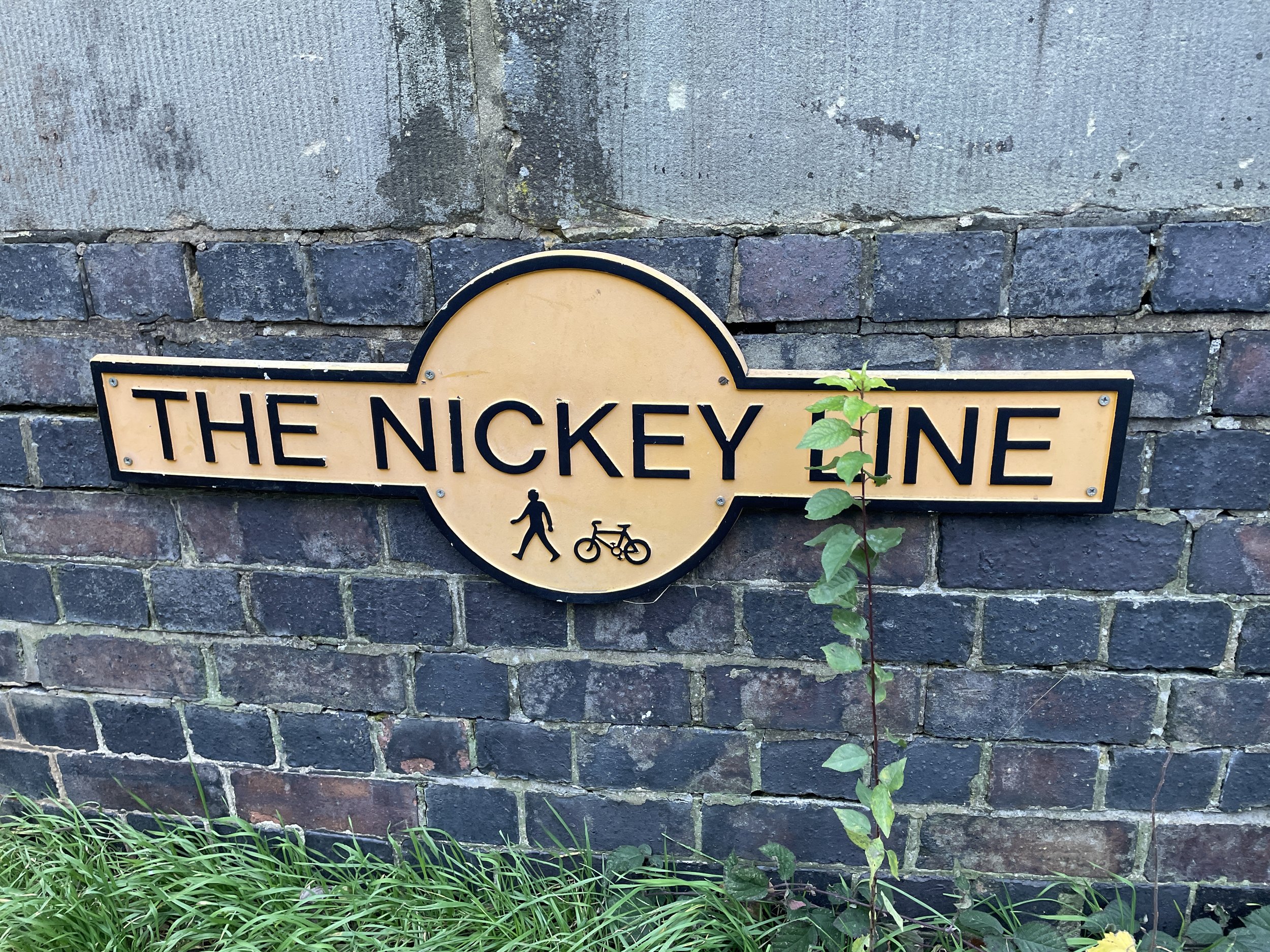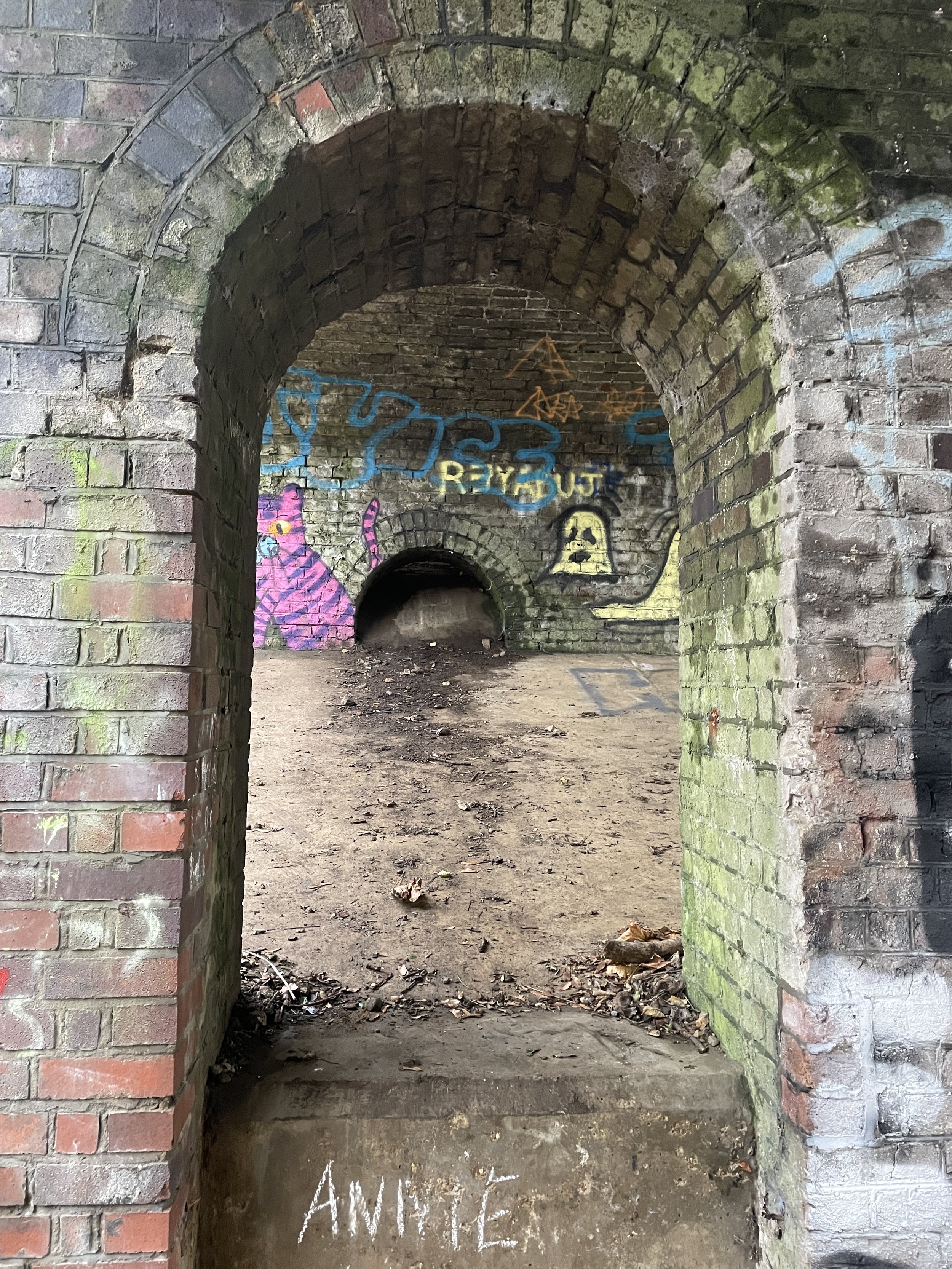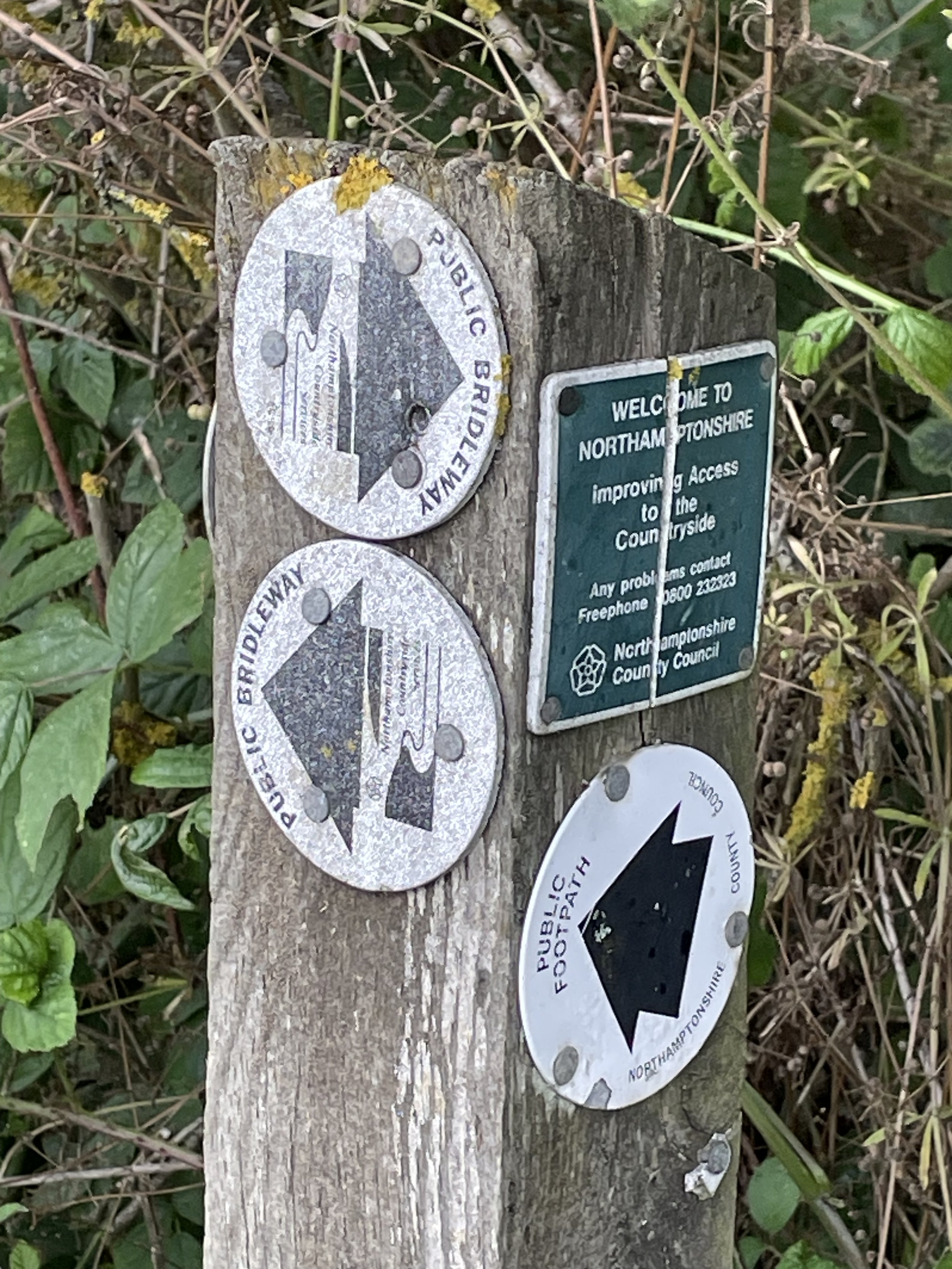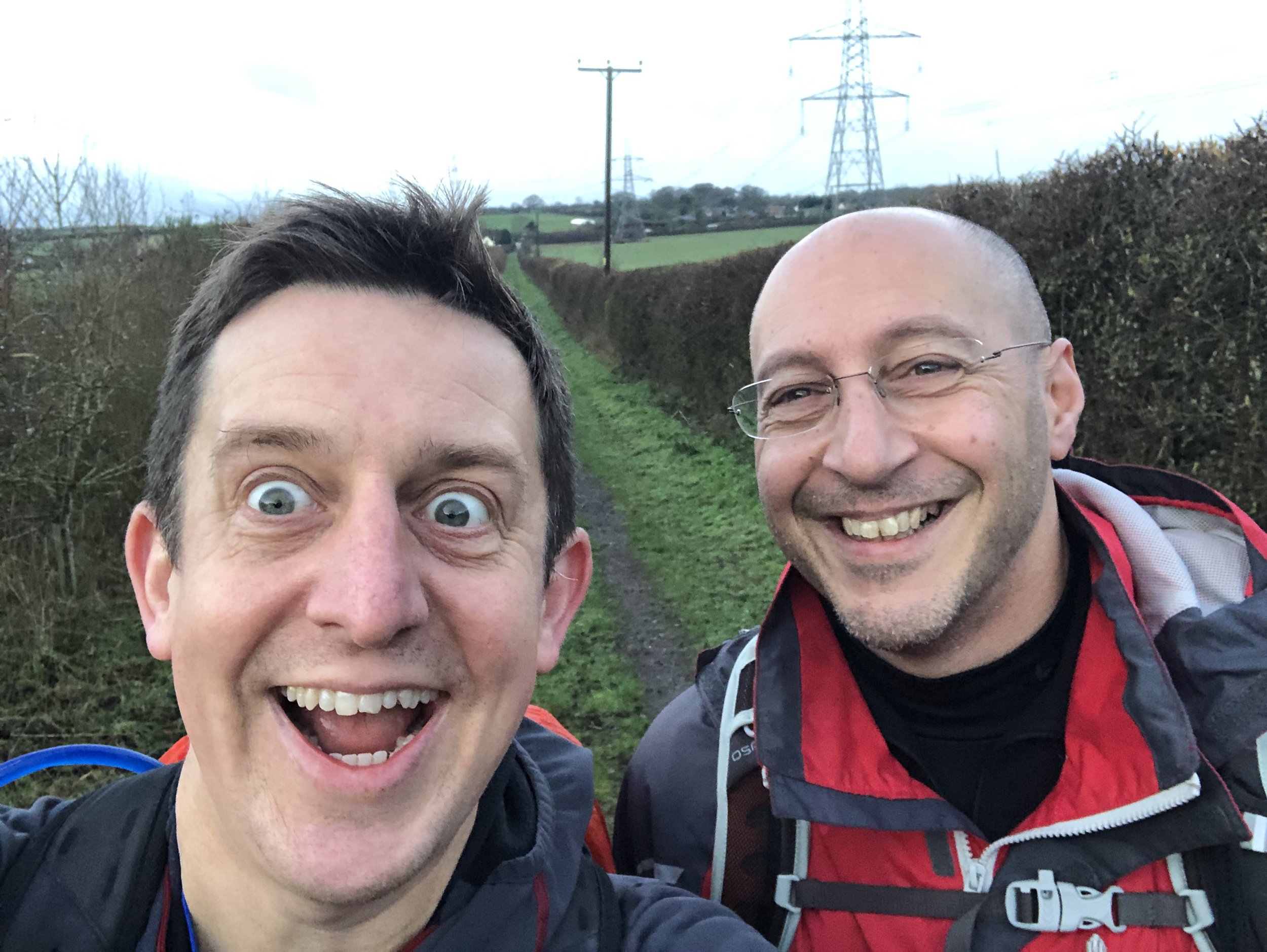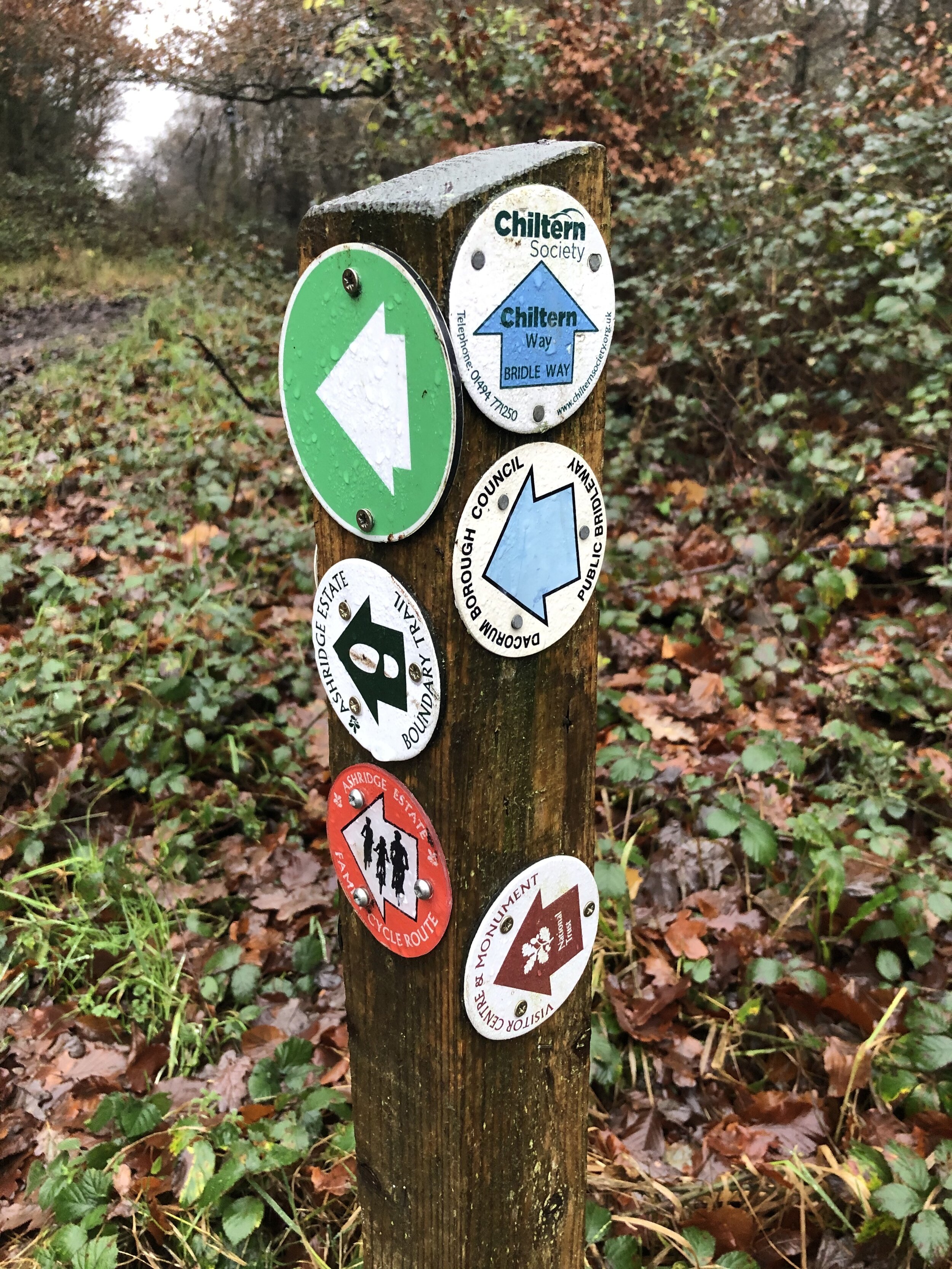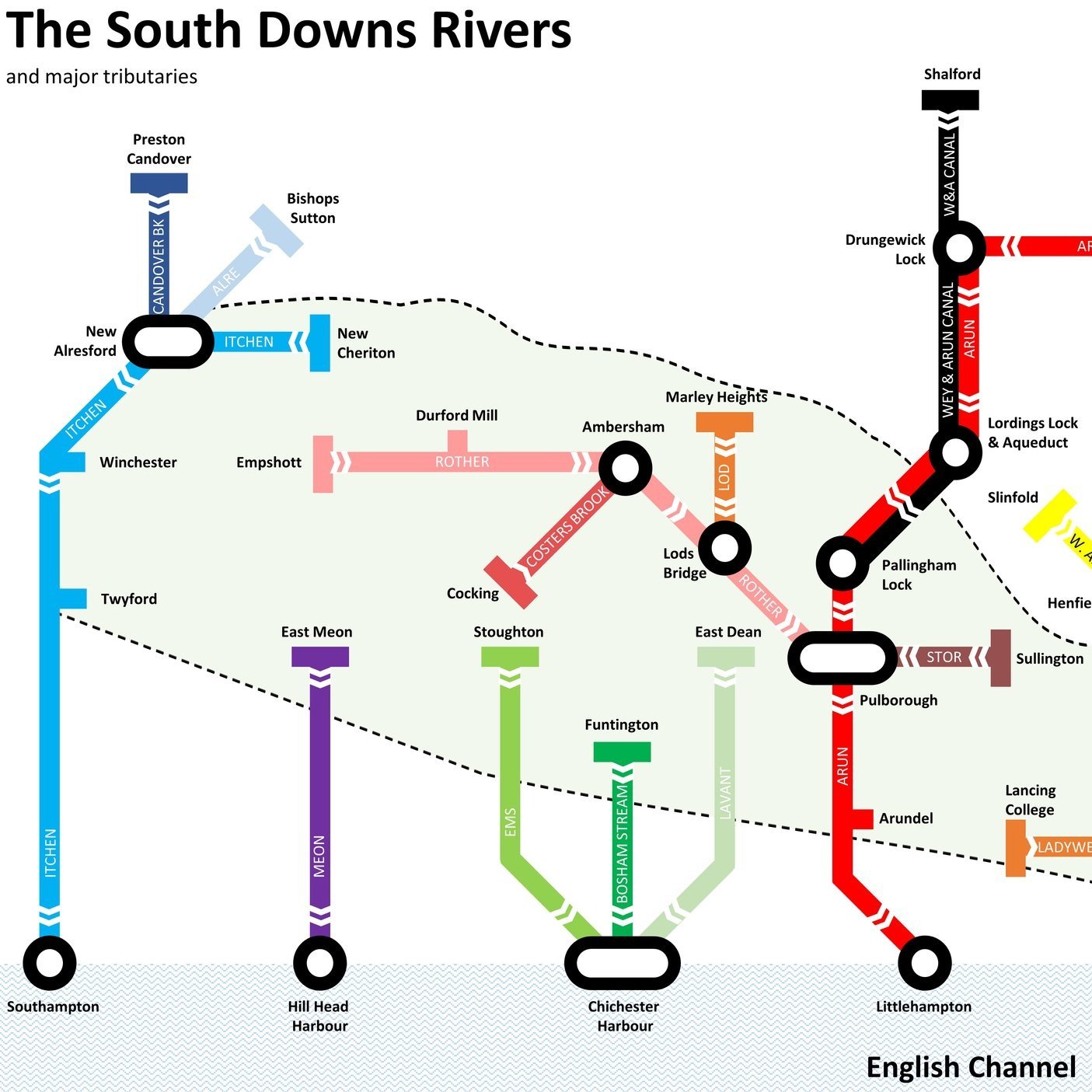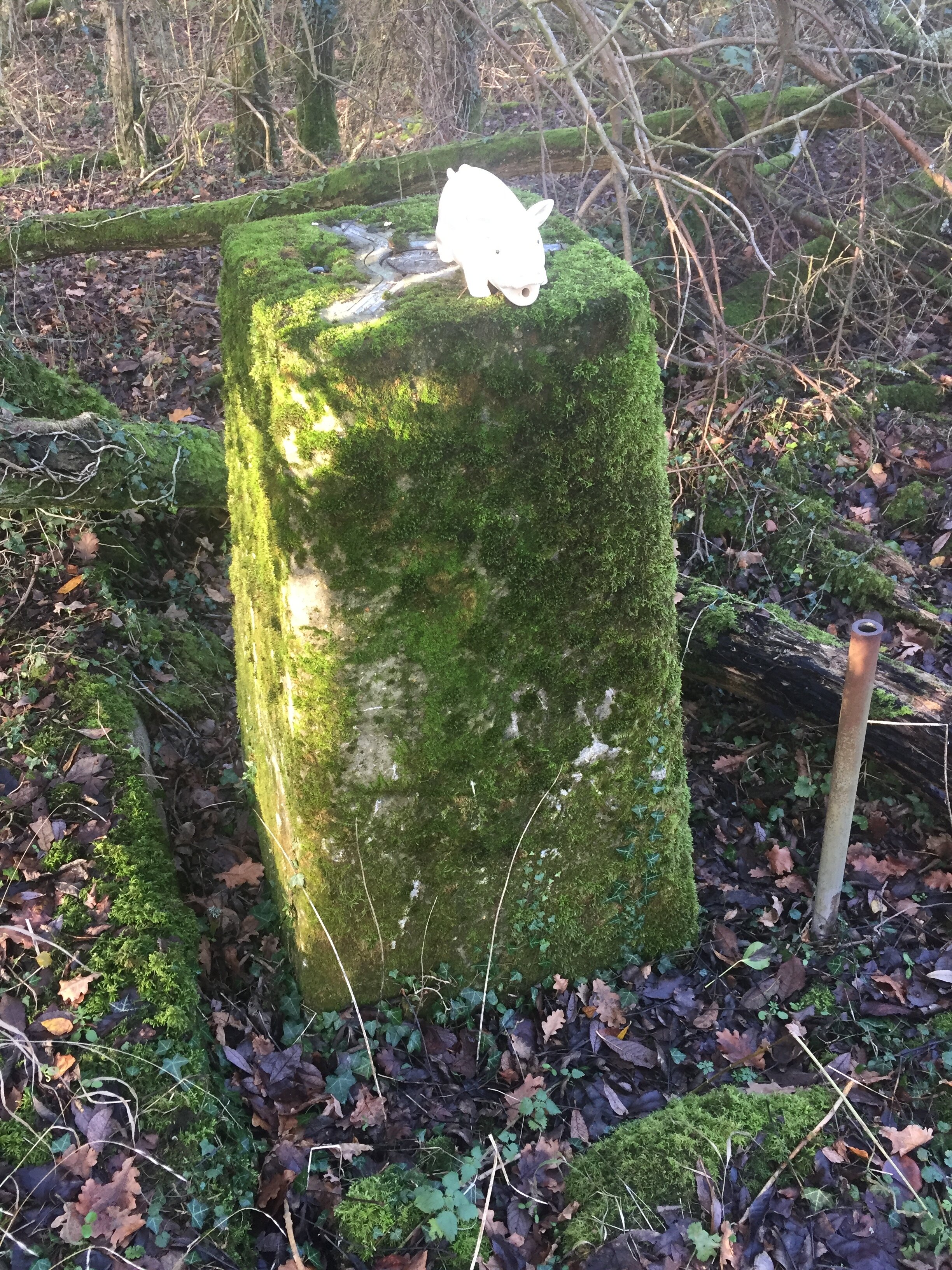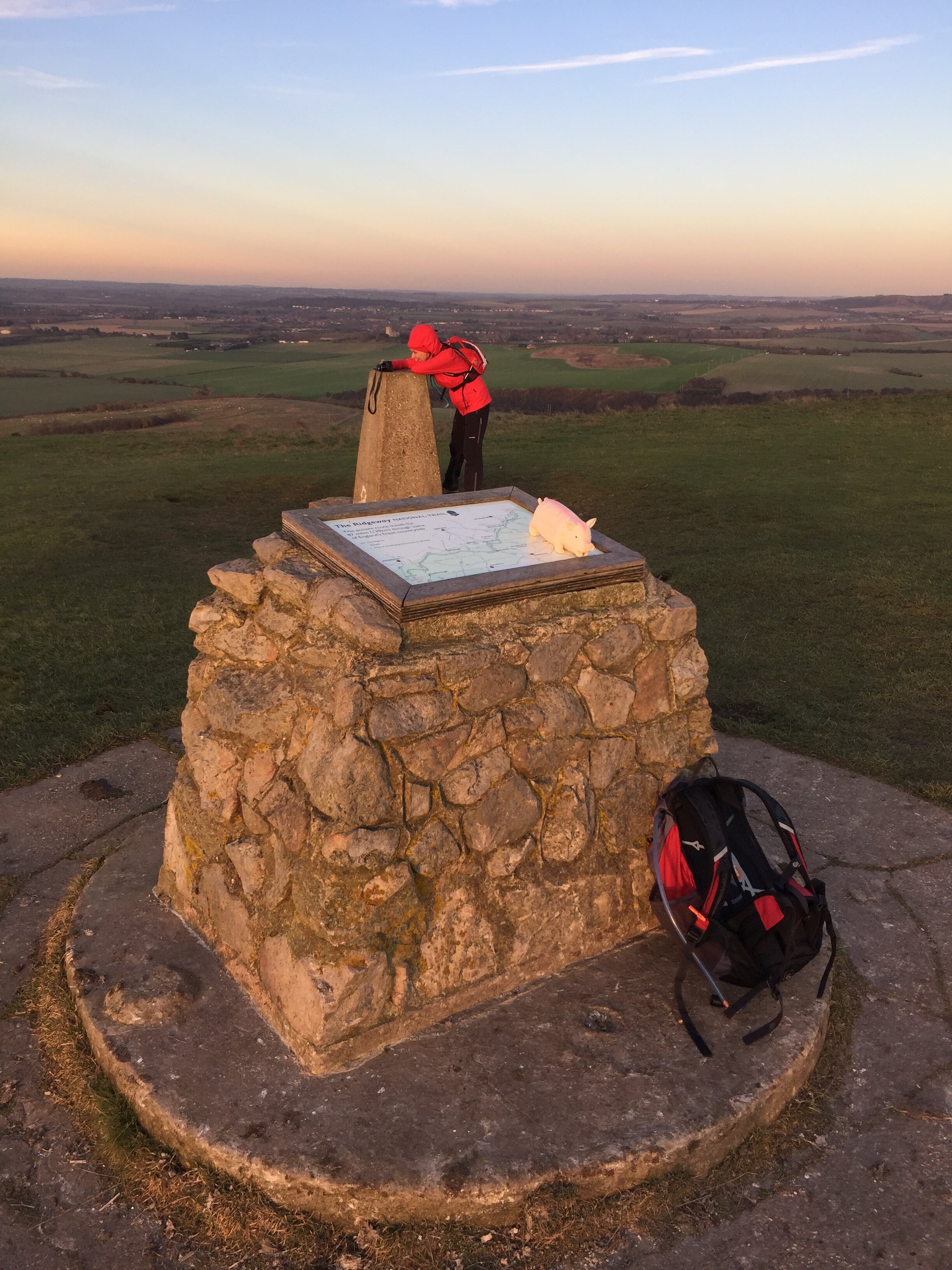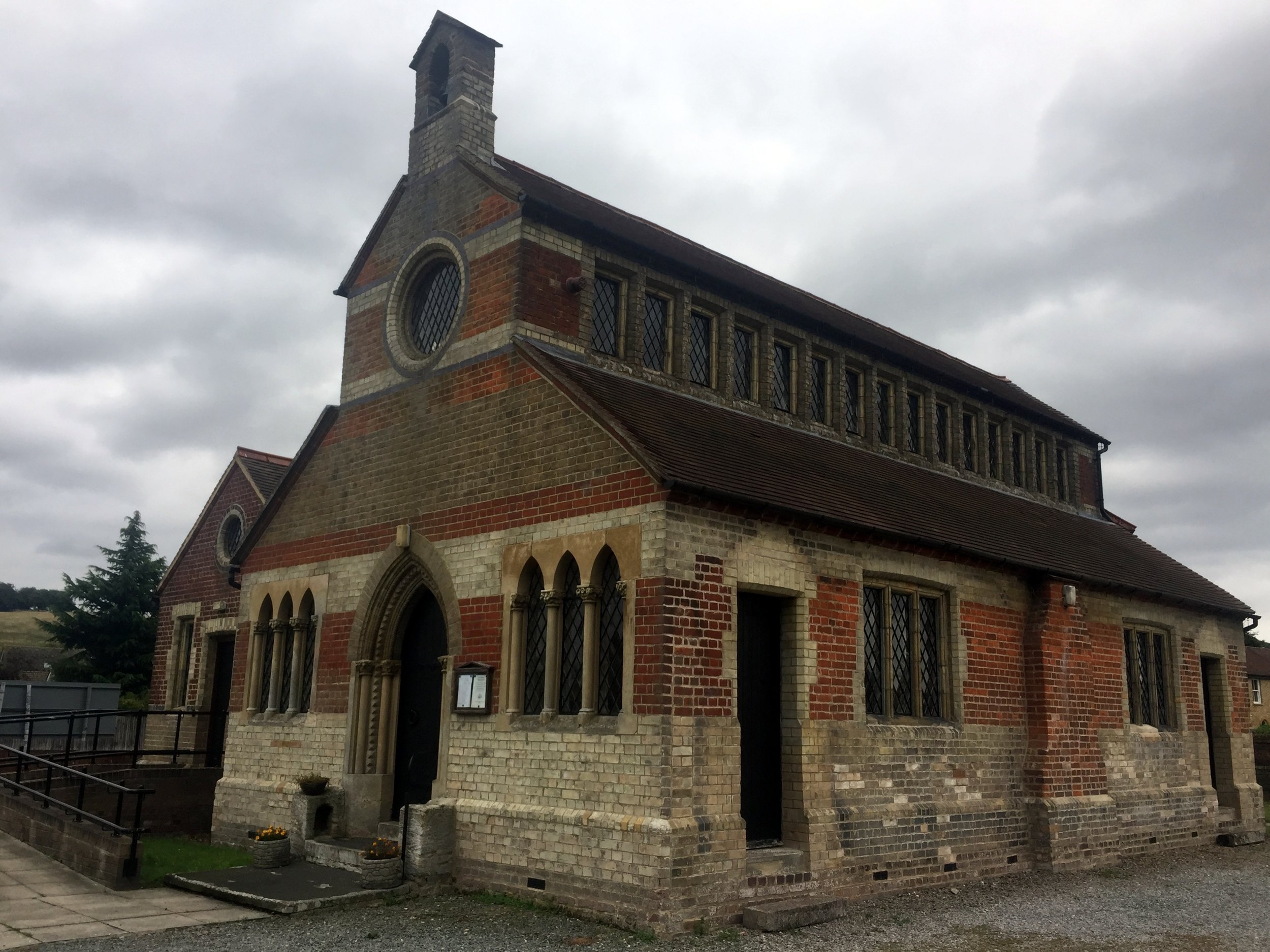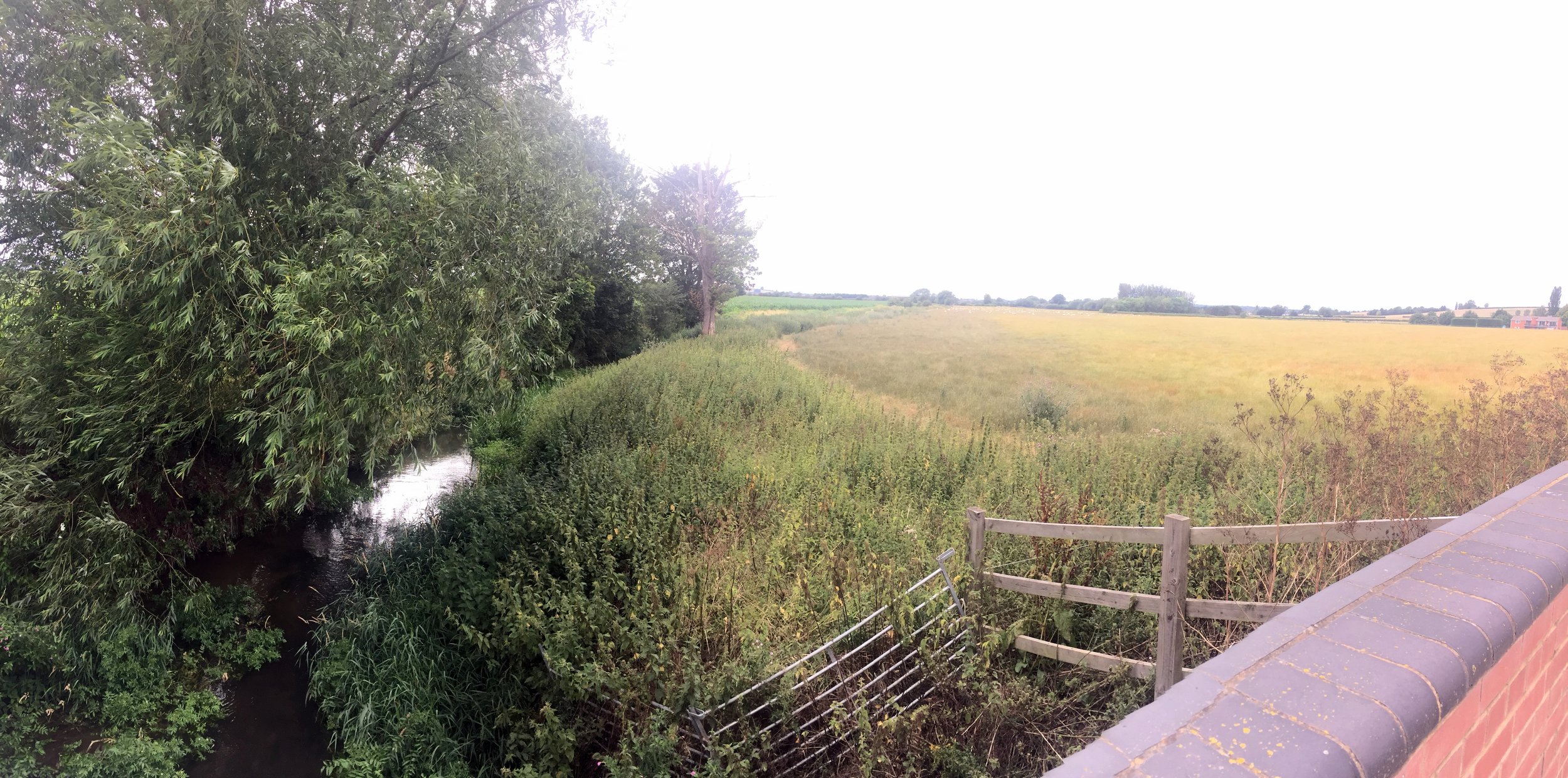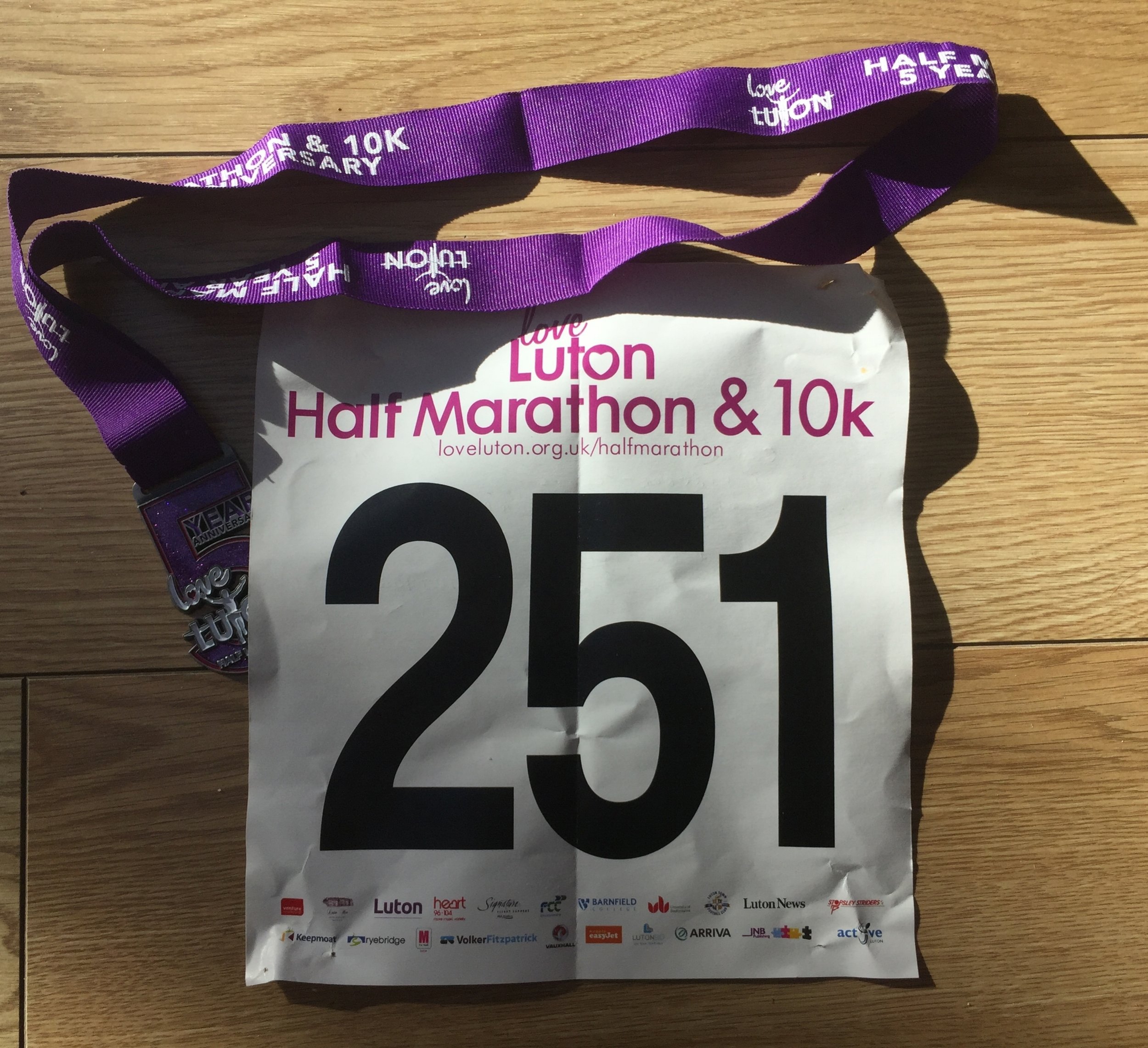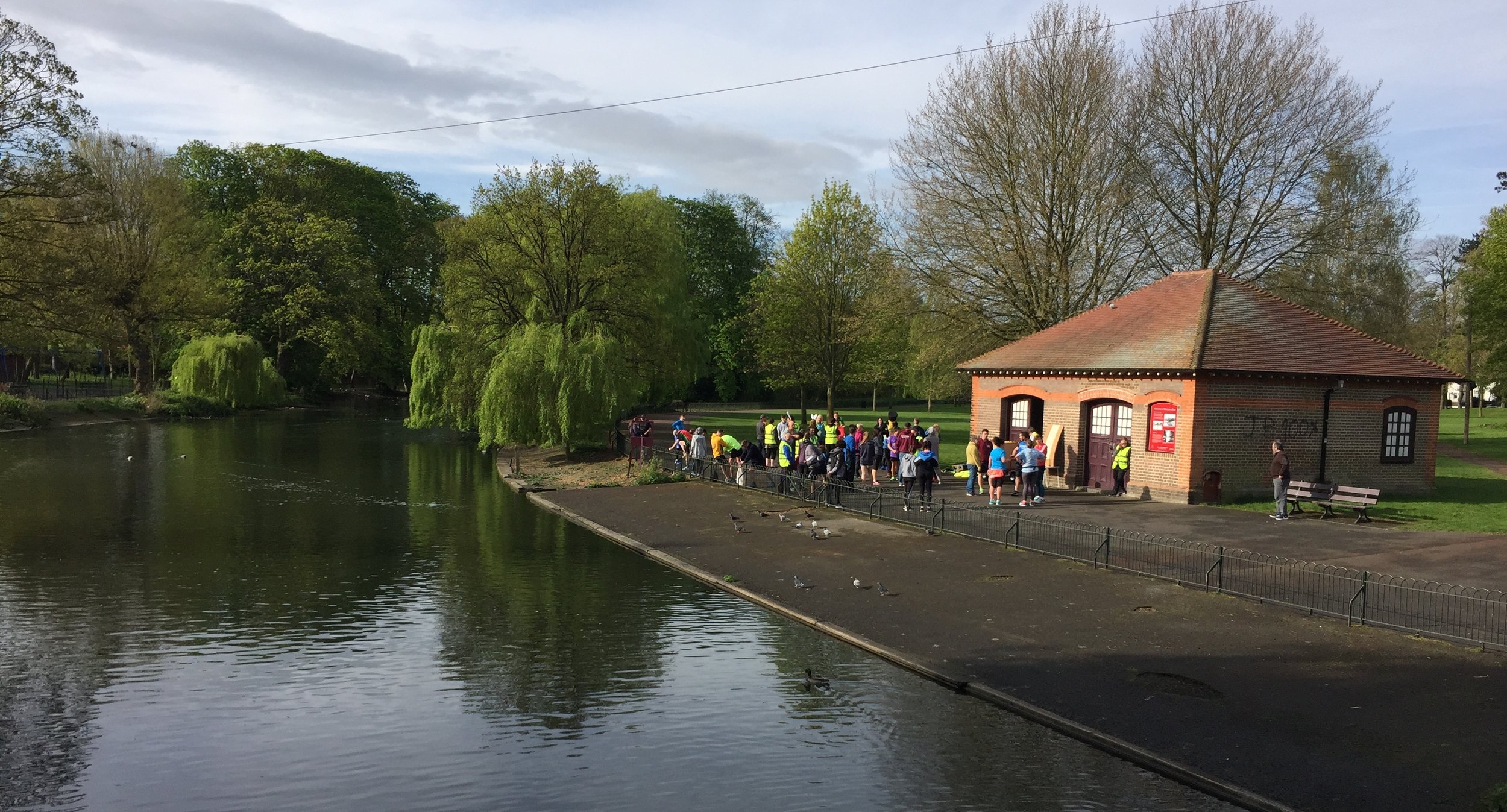When: September 15th 2024
Where: Leighton Buzzard, Bedfordshire
Course: Flatish circuit of south of town from Pages Park to the Grand Union. Mix of trail and pavement
Other routes touched: Grand Union Canal Towpath, Two Ridges Link
Finish time: 56 minutes 57 seconds
View to Sharpenhoe Clappers Hill Fort
Start & Finish: Sharpenhoe Clappers Car Park, 349 Sharpenhoe Road, Sharpenhoe, Bedford, MK45 4SH
Distance: 10.4 km (6.5 miles)
Elevation change: +/- 153m
GPX File: get via Buy Me a Coffee
Other routes touched (walk): Chiltern Way, Icknield Way, John Bunyan Trail
Other routes touched (cycle): Icknield Trail, Chilterns Cycleway
Pubs / Cafes on route: The Chequers, Streatley (4.2 km in)
Map: Luton & Stevenage Map | Hitchin & Ampthill | Ordnance Survey | OS Explorer Map 193
Links: National Trust Sharpenhoe and Sundon Hills, Sharpenhoe Clappers Fort, Streatley, John Bunyan
This is part of a series of short circular walks in the Chilterns. The guidance below will help you navigate but don’t use it as a fully accurate turn-by-turn guide. Always take a map and/or a GPX route and prepare well for the weather and terrain.
Sharpenhoe Clappers is a classic Chilterns walk in the northern exclave of the Chiltern Hills AONB. This is where there’s a gap in the chalk ridge created by the River Lea as is meanders south from Leagrave, through Luton and eventually to London. It’s a lot quieter than the main section of the AONB and has some outstanding views from the top of the ridgeline. The free National Trust Car Park on Sharpenhoe Road is a good place to start. The Chiltern Way, Icknield Way and John Bunyan Trail and route through Sharpenhoe Clappers. This walk is just over 10km but you can create longer or shorter options with different choices on the intersections of these 3 trails.
From here follow the Chiltern Way/John Bunyan Trail heading in a north-easterly direction from the car park. After 100m there’s a fork in the path where you’ll take the left hand path to keep on the Chiltern Way/John Bunyan Trail now heading in a northerly direction. This first 1km takes you along the edge of a peninsular of chalk ridge leading up to the site of the old iron age hill fort. At the tip of the peninsular the John Bunyan Trail continues to the north. Instead, keep on the Chiltern Way as it curves around towards the south, joining the Icknield Way Path after the paragliding take-off spot. Keep following the Chiltern Way as it curves around the ridge to Streatley.
After a rest at the Chequers Inn, continue along Sharpenhoe Road until you reach a footpath on the left leading to the large transmitter towers. Follow this path then take a left onto the Icknield Way/John Bunyan Trail. Follow the path in a westerly direction for 1.5km until the Icknield Way and John Bunyan Trail split. Take a right to keep on the Icknield Way descending to the remains of an old quarry and another Icknield Way/John Bunyan Trail intersection. Take a right to follow the path at the bottom of the ridge back to Sharpenhoe Road. Cross over Sharpenhoe Road and take a right on the path to ascend steeply up to the car park.
Crossing the River Gade
Start: The Bright Star Pub, Kimpton Road, Peter's Green, Luton, LU2 9QP
Finish: Chaulden Adventure Playground, 106 Long Chaulden, Hemel Hempstead, HP1 2HX
Distance: 26.8 km (16.6 Miles)
Elevation change: +288m / -304m. Net -16m
GPX File: get via Buy Me a Coffee
Other Routes Touched (walk): Lee Valley Walk, River Ver Trail, Hertfordshire Way
Other Routes Touched (cycle): Chilterns Cycleway, The Nickey Line, River Lea Cycle Route
Pubs / Cafes on route: Several in Redbourn (10.6 km in), including The Hub Cycle Cafe. Three Blackbirds in Flamstead (15.7 km in)
Maps:
- Luton & Stevenage Map | Hitchin & Ampthill | Ordnance Survey | OS Explorer Map 193
- St Albans & Hatfield Map | Hemel Hempstead & Welwyn Garden City | Ordnance Survey | OS Explorer Map 182
Links: Chiltern Way (Chiltern Society), Redbourn, Flamstead, Hemel Hempstead, River Ver, River Gade
This is the fifth of a series of point to point walks on the Chiltern Way. The full trail is a 134 mile (215 km) long distance path around the Chiltern Hills Area of Outstanding Natural Beauty (AONB). My friend Brian and I have been doing a section a year on or around the Winter Solstice since 2019. At the current rate we plan to be finished in December 2027. The Chiltern Way is well sign-posted however you should take a map or GPX route to keep on track and be prepared for all weathers. This post isn’t intended as a fully accurate turn-by-turn guide.
Having been travelling west to east for the previous 4 sections we had now turned the corner and were heading south, south-west. We were also into more familiar territory as the route covered several trails that we had explored on previous adventures. After 3km from the section start at Peter’s Green the Chiltern Way crosses over the River Lea and briefly follows the Lea Valley Walk towards Harpenden. This section is also on the River Lea Cycle Route.
It had been a while since Brian and I had seen each other and we got so caught up in catching up that we missed the turning off the Lea Valley Walk. After realising our mistake we retraced our steps and followed the Chiltern Way again across to the start of the Nickey Line. This was another familiar section as I had covered it on the Nickey Line, Ayot Greenway and Alban Way cycle ride.
The Chiltern Way follows the Nickey Line for 4.3 km before cutting across the River Ver into Redbourn. We stopped here at The Hub Cycle cafe for a mid-morning coffee and cake. We’d been unlucky on previous Chiltern Way sections finding food as we had either passed pubs before they opened or not passed anything at all. This section passed through more towns so we made a point to stop and eat where we could.
After Redbourn our plan was to continue to Flamstead to arrive there just after 12:00 and in time for lunch at The Three Blackbirds pub. We arrived on time only to find out that the chef was off and they weren’t serving food that day. The nice lady at the bar kindly gave us directions for other places but none were on our route and would have only been practical if driving. We settled for a couple of packets of crisps and had our packed lunch on the move walking out of the village.
The second half of this section is more rural without any towns or villages to pass through. One interesting spot was passing by the front of Gaddeston Place, a large 18th century manor house overlooking the Gade Valley. It looked familiar but not surprisingly as it’s been used as a location in many films and TV series. Coincidentally I saw it again the following evening as it was featured in a movie that I was watching on Netflix.
The Chiltern Way descends sharply down from Gaddeston Place to the B440 Leighton Buzzard Road. be very careful crossing this road as the path opens onto the road at a sharp bend with little visibility. Once across the road the path crosses over the Gade and ascends up the other side of the valley towards Hemel Hempstead.
The end of this section for us was Shrub Hill Common on the north-western edge of Hemel. I had originally planned to finish the section at the Grand Union Canal a couple of km on but parking is better around Shrub Hill.
After a several Winter Solstice dawn to dusk walks we finally got the timings exactly right for this section, starting exactly at sunrise and finishing exactly at sunset.
Harrold Park Farm Trig Pillar, north of the high point along the Three Shires Way
Significance: Unitary Authority High Point for Bedford Borough
Member of: N/A
Parent Peak: Cleeve Hill. NHN = Bow Brickhill
Historic County: Bedfordshire (of which Dunstable Downs is the County Top)
Elevation: 107m
Date climbed: July 15th 2013
Coordinates: 52° 12' 4'' N, 0° 39' 59'' W
Route Start / End: Free on-street parking in or near Church Lane, Bozeat, NN29 7NJ
Route Distance: 6.5 km (4.0 miles)
Route Elevation Change: +/- 39m
Subsidiary tops on route: None
GPX File: get via Buy Me a Coffee
Other routes touched (walk): Three Shires Way
OS Trig Pillar: TP3642 - Harrold Park Farm
Map: Newport Pagnell & Northampton South Map | Towcester & Olney | Ordnance Survey | OS Explorer Map 207
Guidebook: N/A
Links: Wikipedia (Bedford Borough), Peakbagger, Hillbagging
The Slipe is the high point of the Unitary Authority of Bedford Borough, within the Ceremonial and Historic Counties of Bedfordshire.
After a few quick drive-by high-points I was happy to get out of the car for a short walk to the Bedford Borough top. Bozeat is a quiet village with a lot of free on-street parking near the start and end of this route. From Fir Tree Grove follow the footpath for a little over 2km until you reach the junction with the Three Shires Way. The Three Shires Path also runs along the North Northamptonshire / Bedfordshire border at this point. The county tri-point with Milton Keynes is to the south in The Oaks Wood.
The patch of woodland to the east of the Three Shires Way is called the Slipe and the high point is just inside the woods at the northern end. You’ll need to cross over a ditch to get into the woods and there’s nothing to mark the high-point. From the high point you could return to Bozeat the way you came or, as I did, make it a more interesting circular walk to visit the Harrold Park Farm Trig Pillar a further 2.4km along the Three Shires Way. From the Trig Pillar return to Bozeat by taking the westerly heading footpath through the field.
Through fields to Lilley
Start: The Chequers pub, 171 Sharpenhoe Road, Streatley, Luton, LU3 3PS
Finish: The Bright Star Pub, Kimpton Road, Peter's Green, Luton, LU2 9QP
Distance: 20.8 km (12.9 Miles)
Elevation change: +223m / -227m. Net -4m
GPX File: get via Buy Me a Coffee
Other Routes Touched (walk): Chiltern Way, Iknield Way, John Bunyan Trail
Other Routes Touched (cycle): Chilterns Cycleway, Icknield Way Trail
Pubs / Cafes on route: The Chequers at the start and The Bright Star at the end plus The Lilley Arms (just off route at 8.7 km in) and The King William (13.3 km in)
Maps:
- Luton & Stevenage Map | Hitchin & Ampthill | Ordnance Survey | OS Explorer Map 193
- St Albans & Hatfield Map | Hemel Hempstead & Welwyn Garden City | Ordnance Survey | OS Explorer Map 182
OS Trig Pillar: TP6734 - Warden Hill
Links: Chiltern Way (Chiltern Society), Streatley, Luton, Lilley
This is the fourth of a series of point to point walks on the Chiltern Way. The full trail is a 134 mile (215 km) long distance path around the Chiltern Hills Area of Outstanding Natural Beauty (AONB). My friend Brian and I have been doing a section a year on or around the Winter Solstice since 2019. At the current rate we plan to be finished in December 2027. The Chiltern Way is well sign-posted however you should take a map or GPX route to keep on track and be prepared for all weathers. This post isn’t intended as a fully accurate turn-by-turn guide.
It had been 2 years since Brian and I had been on the Chiltern Way. An operation had put him out of action last winter so we skipped a year. Our Summer Solstice way on the River Ver Trail was a good test that his body was functioning again and were back on the trail. We finished Part 2 at Chalk Hill on the A5 but had already covered the next section to Streatley a couple of years previously on the Icknield Way. Rather than cover those 17 km again we picked up the trail at the Chequers pub in Streatley.
From Streatley the Chiltern Way splits off from the Icknield Way for 3 km, reconnecting with it on the ascent up to Warden Hill. After 4.5 km you’ll be at the highest point on this section where you can hop over the fence to bag the Warden Hill Trig Pillar. This is also a great spot to get a panorama of Luton town and the rest of the Chilterns the other side of the gap.
Despite being the highest point on this section, Warden Hill isn’t the highest point in Luton as it’s just outside of the town boundary. You’ll reach the Luton High Point a further 2.5 km from the Trig Pillar at the entrance to Whitehill Farm at the end of Butterfield Green Road. There’s nothing of interest here and I forgot to take a photo to mark the spot, but you can get a good view of it on Google Street View.
From Whitehill the route descends to Lilley where you’ll find the first pub on this section after Streatley. We were looking forward to a morning coffee but had arrived an hour too early and it wasn’t open yet. Instead we pushed on a further 4.5 km to Mangrove to visit the King William pub but also found it to be closed. Getting to pubs at the wrong time was becoming a theme for our Winter Solstice walks. By starting so early in the day we were covering a lot of ground before pubs opened. For this trip there were no more pubs or cafes between Mangrove and the finish point so broke into our emergency rations and carried on.
The final part of this section is a curve around Luton airport. It’s a pleasant section through farms and woodland with the occasional jet descending overhead and a a whiff of kerosene.
This was a much easier section than I expected. The forecast was for heavy rain and I was preparing for the sticky mud that we had experienced on previous sections. As it turned it it was a bright, dry day will little mud. This brought us to the end point at lunch time rather than sunset giving us a shorter than expected Solstice walk. We weren’t complaining though as our main thought was lunch at the Bright Star pub. The good news was that it was open. The bad news was that it wasn’t serving food. We returned by car to the Chequers at Streatley, our lunch stop on the Icknield Way for a big plate of fish and chips.
Don’t get put off by this section when you look at it on a map. By being so close to Luton town and the airport you could mistake it for being a less pleasant part of the Chiltern Way. The reality is that the trail keeps to the hills and farms outside of the town.
Whitehill-Butterfield Green
Significance: Highest point in the Unitary Authority of Luton
Member of: N/A
Parent Peak: Wendover Woods (Haddington Hill), NHN = Dunstable Downs
Historic County: Bedfordshire (of which Dunstable Downs is the County Top)
Elevation: 178m
Date “climbed”: 20th December 2022
Coordinates: 51° 54' 53'' N, 0° 23' 40'' W
Map: Luton & Stevenage Map | Hitchin & Ampthill | Ordnance Survey | OS Explorer Map 193
Links: Wikipedia (Luton), Peakbagger, Hillbagging
Previous section: Walking The Chiltern Way Part 3: Chalk Hill to Streatley
Next section: Walking The Chiltern Way Part 5: Peter’s Green to Shubhill Common
Dunstable Down
Start: Cowroast Lock, 46 Wharf Ln, Tring HP23 5RE
Finish: White Lion Pub, Watling Street, Houghton Regis, Dunstable, LU6 1RS
Distance: 21.9 km (13.6 Miles)
Elevation change: +314m / -315m. Net -1m
GPX File: get via Buy Me a Coffee
Other Routes Touched (walk): Chiltern Way, Iknield Way, Rangers’ Ramble, Foresters’ Walk, Ashridge Boundary Trail, Hertfordshire Way
Other Routes Touched (cycle): Chilterns Cycleway, Berkhamsted Route 6, Grand Union Canal Towpath
Pubs / Cafes on route: Bridgewater Arms, Little Gadesden / National Trust Cafe at Dunstable Downs
Maps: OS Explorer Map (181) Chiltern Hills North and OS Explorer Map (193) Luton and Stevenage
Links: Chiltern Way (Chiltern Society), Cow Roast, National Trust Ashridge Estate, Ashridge, Little Gaddesden, Whipsnade Zoo, Whipsnade, Dunstable Downs National Trust
For our latest Winter Solstice walk we picked up the Chiltern Way from where we left off a year ago. Cow Roast Lock at 08:00 was a bit brighter and significantly less rainy than how we left it in 2019.
As we got into the first hour of the walk Brian and I reflected on some of the changes in a weird year of Covid-19. For the first time since I started my Solstice Walks I wasn’t doing it to unwind from my usual year-end work stress. I hadn’t been to an office since mid-February, had no work-related travel and very little commuting. This gave me a chance to build in more positive daily habits and have more control over my working environment. Year-end at work was still very busy, but now I felt energised rather than exhausted.
This first half of this section of the Chiltern Way was pleasant but with fewer points of interest. Fields and woodland went by in a blur as we caught up on our recent events. The route became more interesting as we ascended out of the Gade Valley after Dagnall and up toward Whipsnade. This part of the Chiltern Way converges with the Icknield Way path that I covered a few years ago in similar damp weather and muddy terrain.
We were walking between Lockdowns 2 and 3 and food stops were few and far between. Normally the Bridgewater Arms at Little Gadesden would have been open when we arrived, but we were too early for their later opening times. The National Trust Cafe at Dunstable Downs was our main hope but the Visitor Centre and Cafe were closed. We has to make do with a pasty and a coffee from the small takeaway hatch at the back. It was drizzling and freezing so we didn’t hang around for long and continued north.
Our finish point was the White Lion Pub on the A5 north of Dunstable. This felt like the obvious target as it was the starting point of our 2nd Icknield Way trip 2 years ago. As that also covered the next section of the Chiltern Way, we’ll start again from Streatley for our next Solstice walk.
Previous section: Walking The Chiltern Way Part 1 - Stokenchurch to Cow Roast
Next section: Walking The Chiltern Way Part 3: Chalk Hill to Streatley
Here’s a Tube-style map of the rivers of the Chiltern Hills AONB and “Greater Chilterns Area”. Let me know if you spot any mistakes and I’ll donate £1 per correction to one of my causes. If you would like a printable PDF version, please Buy Me a Coffee and send me your e-mail via the Contact page. All copies for personal, not commercial use.
It started in 2016 with my Winter Solstice walk along the River Chess. I loved the walk and soon my mind turned to contemplating how many rivers there were in the Chilterns. More importantly, how many of them could be walked, cycled or ran? Over the following few weeks I went on a desk-based adventure researching the source and mouth of every waterway in the area. Unlike the Chess most of them don’t have a well-signed path following them. For these I started planning cycle trips to discover them. These would be circular routes, one section keeping as close as possible to the river, and the other section a return trip along quiet country lanes.
Each trip took me to places I’d not been to before. It also taught me a lot about the geography of an area that I’d grown up near but knew little about. I could see first hand how the rivers formed the valleys that cut through the chalk hills. I also discovered how many of the towns and villages that I knew so well were named after the river that runs through them.
The tricky part what knowing when the adventure would come to an end. Every time I got close I discovered a new stream that I never heard of and had to find that one too. I also had to make a decision about what would classify as a Chiltern River. The main criteria was that either the source had to be in the Chiltern Hills AONB and / or most of the river’s length had to be through the Greater Chilterns area. Some didn’t quite match this but I included them anyway. The Lea, for example, originates North of Luton in the gap between the 2 sections of the AONB. From here it flows away from the Chilterns to meet the Thames on the other side of London. It still felt like a Chiltern River though so I included it. I’m very happy that I did as the cycle trip along it was one of the most enjoyable of the set.
There’s a few that I didn’t include. The Flit and the Hiz both touch the Greater Chilterns area but originate outside of it. I may explore them later but for now I’m happy to give them a miss. I’m sure that there will be other rivers, streams or waterways that I have missed. If you know of any and have a recommendation for an adventure that includes them, post a note in the comments section below.
Scroll down for maps, links to blog posts for each river-based trip and a section on Chilterns towns that take their names from the rivers.
Click on the linked river name below to see the blog post for each river-based trip.
Alderbourne: Source in Fulmer, runs ~5 miles to the Colne Brook at Iver Heath, Buckinghamshire
Ash: Splits from the Colne on Staines Moor, runs ~6.2 miles to meet the Thames at Walton-on-Thames, Surrey
Assendon Stream: Source in Stonor, runs ~4 miles to the River Thames at Henley-on-Thames, Oxfordshire
Bulbourne: Source at Cow Roast, runs ~7 miles to the River Gade at Two Waters, Apsley, Hertfordshire
Chess: Source in Chesham Vale, Buckinghamshire, runs ~11 miles to the River Colne at Rickmansworth, Hertfordshire
Colne: Source near North Mymms, Hertfordshire, runs ~11.2 miles to the the Thames at Staines, Surrey
Colne Brook: Splits from the Colne at Uxbridge Moor, Greater London, runs ~9 miles to the Thames at Hythe End near Staines, Surrey
Ewelme Brook: Source in Ewelme Village, runs ~2 miles to the Thames near Benson Lock, Oxfordshire
Frays River: Splits from the Colne at West Drayton, Greater London, runs ~5.5 miles and rejoins the Colne near Staines, Surrey
Gade: Source at Dagnall, Buckinghamshire, runs ~16 miles to the Colne at Rickmansworth, Hertfordshire
Hambleden Brook: Source at Skirmett, runs 4.1 miles to meet the Thames at Mill End, Buckinghamshire
Hugenden Stream: Sourced from springs near Hughenden Village, runs ~2.2 miles to meet the Wye in High Wycombe
Lea: Source in Leagrave, Bedfordshire, runs 42 miles to meet the Thames at Leamouth, Greater London
Mimram: Source near Whitwell, runs 12 miles to the River Lea at Hertford, Hertfordshire
Misbourne: Source at Great Missenden, runs ~17 miles to the Colne at Denham, Buckinghamshire
Ouzel: Source at Dagnall, runs 20 miles to join the River Great Ouse at Newport Pagnell, Buckinghamshire
Pinn: Source at Pinner, runs approx, 11.4 miles joining the Grand Union and the Frays at Yiewsley, Greater London
Wraysbury: Splits from the Colne at West Drayton, runs ~5.5 miles and rejoins the Colne near the confluence with the Thames at Staines, Surrey
Ver: Source at Kensworth, Bedfordshire, runs ~15 miles to the Colne at Bricket Wood, Hertfordshire
Wye: Source at Bradenham, runs 9 miles to the Thames at Bourne End, Buckinghamshire
Canals & other man made waterways
Wendover Arm Canal
Poyle Channel
Staines Rivers Aqueduct
Wraysbury Lakes Ditch
Chilterns Towns Taking Their Name from the Rivers.
Ashford - River Ash
Bricket Wood - Rivers Ver and Colne: "Bright-coloured small island or piece of marshland"
Bourne End (Buckinghamshire) - River Wye
Bourne End (Hertfordshire) - Bourne Gutter, a short stream that flows into the Bulbourne near Hemel Hempstead
Chalfont St. Giles - River Misbourne. Chalfont means "spring frequented by calves"
Chalfont St. Peter - River Misbourne. Chalfont means "spring frequented by calves"
Colnebrook - Colne Brook (obviously)
Colney - River Colne. Also London Colney, Colney Heath
Fordbridge - River Ash
Fulmer - Alderbourne. Means "Mere or lake frequented by birds", possibly due to the small lakes feeding the river at the end of Framewood Road
Gadebridge - River Gade
Great Gaddesden - River Gade
Great Missenden - River Misbourne
Halliford (Upper and Lower) - River Ash. Means “holy ford”
Little Missenden - River Misbourne
Leagrave - River Lee (possibly - alternative meaning exist that are not connected to the river)
Longford - River Colne and Wraysbury: "Long Ford across the river"
Loudwater - River Wye
Luton - River Lee: "Farmstead on the River Lee"
Pinner - River Pinn
Redbourne - River Ver: "reedy stream", reedy could be a derivation of Reade who owned the manor in the 16th century
Ruislip - River Pinn (could also be Yeading Brook): "leaping place across a river where rushes grow"
High Wycombe - River Wye
St Albans (Roman name = Verulamium) - River Ver
Stanwell - River Colne - "Stoney spring or stream"
Two Waters - Rivers Gade and Bulbourne
Watford - River Colne - "Ford used when hunting"
Wooburn Green - River Wye
Wraysbury - Wraysbury River. River could be named after the town. Strangely the river doesn't go through the town, although the Colne Brook Does
Uxbridge - River Colne: "Bridge of the tribe called the Wixan"
Primary sources: A Dictionary of British Place Names (Mills) and Wikipedia
Tube-style Maps
Boxing Day 2019 saw the completion of my mission to find all of the Trig Pillars in the Chilterns. I used my broader definition of the Chilterns which extends beyond the boundaries of the AONB to the banks of the Thames, Lea and Colne. I also kept it to those that were accessible without trespassing, damaging crops or fences or scaring animals. That definition is somewhat subjective though as some that I’ve listed as accessible are just off the public right of way. Looking at the logs, there’s others who have successfully bagged ones I’ve listed as inaccessible but I’ve taken a more risk-averse approach, missing out on 7 pillars. As with my Chilterns Rivers adventures this has taken me to some stunning countryside that I wouldn’t have seen otherwise.
Notes to Map Key:
Green shaded area is the Chiltern Hills AONB (Area of Outstanding Natural Beauty)
Peach shaded area is the “Greater Chilterns Area”, bordered by the River Thames to the South and West, the River Lea to the North East and the River Colne to the East.
Green Triangles show accessible Trig Pillars: either on a public right of way or just off and accessible with care.
Yellow Triangles show inaccessible Trig Pilars: those on private property and not accessible without land-owners’ permission.
Red Triangles show destroyed or missing Trig Pillars.
Letters and numbers before each Trig Pillar name below refer to the grid reference in the map above.
Accessible Trig Pillars in the Greater Chilterns Area
Accessible Trig Pillars in the Chiltern Hills AONB
(C2) TP5451 - Pink Hill
(C2) TP6698 - Wain Hill
(C3) TP0919 - Atkins Farm
(C4) TP2470 - Cowcroft
(D1) TP3516 - Grims Ditch
(D1) TP5194 - Nuffield
(D1) TP6886 - White Hill
(D2) TP3127 - Fawley
(D3) TP6938 - Widmere
(E2) TP1375 - Birch Heath
Inaccessible Trig Pillars in the Greater Chilterns Area
Inaccessible Trig Pillars in the Chiltern Hills AONB
(D2) TP5157 - North End
(D2) TP6081 - Southend
(E1) TP1555 - Bozedown
Destroyed Trig Pillars in the Greater Chilterns Area
Destroyed Trig Pillars in the Chiltern Hills AONB
(D2) TP5082 - Nettlebed
(D3) TP10099 - Widmere
Related Blog Posts:
Books and Maps:
There are currently 7 parkrun events in present-day Bedfordshire. The first was Bedford which started on June 11th 2011 and the newest is Henlow Bridge Lakes which started on September 25th 2021. The name for having completed all parkrun events in the county is “Made the Beds”
I first completed the county on August 24th 2019 at Bedford.
Note that the address for Rushmere parkrun is in Bedfordshire but the whole of the parkrun course is in Buckinghamshire so I have listed it there.
The interactive maps below take you to the approximate location for the course, typically the centre of the park. See the course instructions in the parkrun page for each event for specific directions to the start. Course maps show the route at the time that I ran it and may have changed since then.
Bedford
I completed this event on: August 24th 2019 with a finish time of: 26:06
Other routes touched (walk): John Bunyan Trail
Inaugural: June 11th 2011
Links: Event Home Page, Course Page, blog7t write-up
Dunstable Downs
I completed this event on: May 18th 2019 with a finish time of: 28:35
Other routes touched (walk): Icknield Way, Chiltern Way
Other routes touched (cycle): Icknield Way Trail
This event is also part of Chilterns parkrun
Inaugural: February 23rd 2019
Links: Event Home Page, Course Page, blog7t write-up
Great Denham
I completed this event on: July 27th 2019 with a finish time of: 25:50
Other routes touched (walk): Ouse Valley Way
Inaugural: February 17th 2018
Links: Event Home Page, Course Page, blog7t write-up
Henlow Bridge Lakes
I completed this event on: November 6th 2021 with a finish time of: 26:47
Other routes touched (walk): Hicca Way, Kingfisher Way
Other routes touched (cycle): none but NCN 12 runs past the entrance.
Inaugural: September 18th 2021
Links: Event Home Page, Course Page, blog7t write-up
Houghton Hall
I completed this event on: New Year’s Day 2018 with a finish time of: 27:02
Other routes touched (cycle): NCN 6
This event is also part of Chilterns parkrun
Inaugural: December 23rd 2017
Links: Event Home Page, Course Page, blog7t write-up
Luton Wardown
I completed this event on: April 15th 2017 with a finish time of: 26:51
Other routes touched (walk): Lee Valley Trail
Other routes touched (cycle): N/A, but the Western edge of the course runs close to a parallel with NCN 6
This event is also part of Chilterns parkrun
Inaugural: April 18th 2015
Links: Event Home Page, Course Page, blog7t write-up
Millennium Country
I completed this event on: July 16th 2019 with a finish time of: 26:09
Other routes touched (cycle): NCN 5
Inaugural: March 23rd 2019
Links: Event Home Page, Course Page, blog7t write-up
Actual course outlines for the parkrun events in present-day Bedfordshire.
More parkrun posts
parkruns are free, weekly, community 5k events all around the world. I started in December 2012 and have been obsessive about it ever since. See my parkrun Collection page for details.
Featured and popular parkrun posts:
Bridge over the River Ouzel near Edlesborough
Part of the Chiltern Rivers Series
River start: Dagnall, Buckinghamshire
River end: Confluence with the River Great Ouse and Newport Pagnall
River length: 32 km (~20 miles)
Cycle route start / end: Dagnall Church, HP4 1RL
Cycle route length: 31.2 km / 19.4 miles
Cycle route elevation change: +/- 191 m
GPX File: get via Buy Me a Coffee
Other routes touched (walk): Icknield Way, Grand Union Canal, Two Ridges Link
Other routes touched (cycle): NCN Route 6
Map: OS Explorer Map (181) Chiltern Hills North
Links: River Ouzel, Dagnall, Edlesborough, Leighton Buzzard
This one firmly belongs in the “obscure and tenuous” section of my Chilterns Rivers project. It counts because the source of The Ouzel is in Dagnall which is firmly within the boundary of the AONB. However, it soon escapes and 95% of its course is outside of the Chilterns. From Leighton Buzzard the river follows the course of the Grand Union Canal to Milton Keynes where it splits off and joins the River Great Ouse at Newport Pagnell. I wasn’t up for cycling the Grand Union yet again so I confined my ride to exploring the first 12km.
Dagnall Church is a good place to start the ride. From here take the B440 North and take a right onto the B489. The Ouzel rises in the farm bounded by these 2 roads and crosses the B489 before the sign for Central Bedfordshire. This is the first first and most underwhelming of the 5 road crossings en route its way to Leighton Buzzard. The rest of this outbound section is a pleasant meander through small country lanes and villages with a few pubs and cafes for rest stops along the way.
At Leighton Buzzard, the return is very simple as it follows the Grand Union Canal towpath for approx 6.5 miles to Cheddington. From here, cross over at the lock and, after a farm, follow Chapel Lane through Ivinghoe Aston back to the B489. The end point at Dagnall is 3 km from this junction.
Its a bit of a weird route but actually quite interesting. There’s good views of Ivinghoe Beacon and the Whipsnade White Lion from several parts. From Dagnall you can pick up the River Ver and trace that South to the Colne. Alternatively, the Ridgeway and Icknield Way converge at Ivinghoe Beacon.
Blue = River, Red = Cycle Route
Elevation for cycle route
Sheep at Sunrise near Chalk Hill
Start: White Lion Pub Watling Street, Houghton Regis, Dunstable, LU6 1RS
Finish: The Chequers, 171 Sharpenhoe Road, Streatley, Luton, LU3 3PS
Distance: 16.4 km (10.2 Miles)
Elevation: +184m / -149m. Net +35m
GPX File: get via Buy Me a Coffee
Other Routes Touched (walk): Chiltern Way, Icknield Way, Chalgrave Heritage Trail, John Bunyan Trail
Other Routes Touched (cycle): Chilterns Cycleway, Icknield Way Trail (cycle route)
Pubs / Cafes on route: White Lion (at start), The Old Red Lion (1.8 km in), The Star (6.4 km in), Red Lion Sundon (9.1 km in), The Chequers (at end).
Map: OS Explorer Map (193) Luton and Stevenage
Links: Houghton Regis, Chalton, Sundon, National Trust Sharpenhoe, Streatley
This is the third of a series of point to point walks on the Chiltern Way. The full trail is a 134 mile (215 km) long distance path around the Chiltern Hills Area of Outstanding Natural Beauty (AONB). My friend Brian and I have been doing a section a year on or around the Winter Solstice since 2019. At the current rate we plan to be finished in December 2027. The Chiltern Way is well sign-posted however you should take a map or GPX route to keep on track and be prepared for all weathers. This post isn’t intended as a fully accurate turn-by-turn guide.
We had already covered this section of the Chiltern Way a couple of years before when walking the Chalk Hill to Pirton section of the Icknield Way. Not feeling the need to retrace these 16 km, we picked up again at Streatley (see part 4 of Walking The Chiltern Way).
Looking back at the map when writing the Chiltern Way posts it looks like the Chiltern Way between Chalk Hill and Streatley now takes a different route to the Icknield Way. Presumably this was due to the development of housing and distribution warehouses around the A5/M1 corridor.
Previous section: Walking The Chiltern Way Part 2 - Cow Roast to Chalk Hill
Next section: Walking The Chiltern Way Part 4: Streatley to Peter’s Green
There’s only 4 parkrun events in the Chiltern Hills Area of Outstanding Natural Beauty, but the Chilterns covers a much larger area. I’ve not seen a common definition, so I’ve decided to select the boundaries marked by the rivers Thames, Colne and Lea. Most of the rivers and streams that start in the Chiltern Hills eventually flow into these 3 rivers, so it feels like the best boundary. One could argue that the area could also include everything south of the Lea before it reaches the Thames at Limehouse Basin, but that would include most of North London too.
So, the Greater Chilterns area, a beautiful and adventure-filled region, contains 17 parkrun events so far. It also includes my home event, Black Park and 2 of my hilliest favourites, Church Mead and Wendover Woods. Here’s the links:
Actual course outlines for the parkrun events in the greater Chilterns area.
parkrun events within the Chilterns Hills AONB
Tring (now permanently cancelled)
parkrun events within the greater Chilterns AREA
More parkrun posts
parkruns are free, weekly, community 5k events all around the world. I started in December 2012 and have been obsessive about it ever since. See my parkrun Collection page for details.
Featured and popular parkrun posts:
When: September 2nd 2018
Where: Dunstable Downs, Bedfordshire, UK
Course: Single loop starting at Creasey's Park Community Football Centre, Dunstable, heading up over Dunstable Downs on the Icknield Way across the National Trust grounds. Loops back through Studham Common, returning to base back along the Downs. Lovely views.
Other routes touched (walk): Icknield Way, Chiltern Way
Other routes touched (cycle): Chilterns Cycleway
Finish time: 2 hours 11 mins (Hot + Hilly)
When: October 29th 2017
Where: Luton, Bedfordshire, UK
Course: Tarmac, mix of park and city. Starts at Stockwood Discovery Centre, through Luton Hoo Estate, City Centre, Wardown Park, ending in the Town Hall Square.
Other routes touched (walk): Lea Valley Walk,
Other routes touched (cycle): NCN 6
Finish time: 1:59
Grand Union at The Grove, Watford
Part of the Chiltern Rivers Series
River start, end and length
- Gade: starts near B440 in Dagnall, Buckinghamshire, runs 25 km (16 miles) to the River Colne in Rickmansworth, Hertfordshire
- Ver: starts in the grounds of Lynch Lodge, Kensworth Lynch, runs 24 km (15 miles) to the River Colne in Bricket Wood, Hertfordshire
Cycle route start / end: Rickmansworth Aquadrome, Frogmoor Ln, Rickmansworth WD3 1NB
Cycle route length: 78 km (48.5 miles)
Cycle route ascent: +/- 437m
GPX File: get via Buy Me a Coffee
Other routes touched (walk): Chiltern Way, Hertfordshire Way, Icknield Way, River Ver Trail
Other routes touched (cycle): NCN routes 57, 6, 61, Chilterns Cycleway, Nickey Line, Grand Union Canal Towpath
Map: OS Explorer Map (181) Chiltern Hills North, OS Explorer Map (182) St. Albans and Hatfield, OS Explorer Map (172) Chiltern Hills East
Links: Rickmansworth Aquadome, Hemel Hempstead, Dagnall, Whipsnade, Kensworth, Markyate, St Albans, Bricket Wood
Today's 50-mile cycle trip was both a training session for July's Ireland trip and a 2 ticks for the price of 1 for the Chiltern Rivers. Both the Gade and the Ver start high in the Chilterns and meander south, eventually joining the Colne. Neither has well-defined paths next to the rivers, so they're best followed by bike along nearby roads.
The Gade can be seen many times after Hemel Hempstead as it keeps close to the main road to Leighton Buzzard. The Ver was less interesting and I barely saw it at all on the trip. The River Ver Trail, which I noticed on a few signs whilst speeding by, is a better way to see the river at a much slower pace.
The cycle route makes for a very pleasant adventure with a mix of canal, parks, country roads and quaint villages. There's a few stretches along busier A roads, but nothing too scary. The downhill stretch through Whipsnade and Kensworth after climbing Bison Hill is a particular highlight.
Here's the route:
The Gade
Start at the free car park at Rickmansworth Aquadome.
Follow Grand Union Canal north to Hemel Hempstead
Turn right onto Two Waters Road heading north. Take the underpass under the Plough roundabout.
Keep the Gade to your left, taking Waterhouse Street then Marlowes to Gadebridge Park
Keep to the right of Gadebridge Park, exiting to Piccots End Road, continuing to Leighton Buzzard Road.
Continue north until the Red Lion pub at Dagnall. Celebrate with lunch.
Between the Gade and Ver
After the Red Lion, double back for a couple of hundred metres then turn left onto the Dunstable Road towards Whipsnade.
After about a mile turn right onto the B4540, taking the steep(!) Bison Hill up to Whipsnade.
Continue past Whipsnade village, eventually reaching Kensworth, the source of the Ver.
The Ver
Continue along the B4540 until it reaches the A5, turn right.
Follow the A5 to the M1 junction, briefly diverting along Old Watling Street just past Markyate.
After the M1 junction, continue straight on Dunstable Road to the roundabout at the edge of St Albans.
Take the 3rd exit onto the A4147, following signs for Old Verulamium.
At the park, follow signs for the St. Albans Greenway until it meets NCN Route 6/61
Turn right / south onto NCN Route 6/61, following it all the way back to Rickmansworth Aquadrome.
The Ver meets the Colne just south-east of Bricket Wood station. I didn't search for it but, from the map, it looks like you can there via Drop lane, opposite the station.
Return to the Start
From Bricket Wood, continue on NCN 6/61 to Rickmansworth Aquadrome
Above: Red shows the course of the Gade and Blue shows the Ver. Green shows the cycle route.
Elevation for cycle route
Near River Lee Country Park
Part of the Chiltern Rivers Series
River Lea start: Leagrave, Bedfordshire
River Lea end: Leamouth, Greater London
River Lea length: ~42 miles / 68 km
Cycle route start / end: Wardown Park, Luton, Bedfordshire
Cycle route length: ~58 miles / 94 km
Cycle route ascent: +420m / -507m
GPX File: get via Buy Me a Coffee
Other routes touched (walk): Lea Valley Walk, Chiltern Way, Hertfordshire Way, New River Path, Greenwich Meridian Trail, London Loop, Capital Ring, The Greenway, Jubilee Greenway, Regent’s Canal Towpath
Other routes touched (cycle): NCN Routes 1, 12, 57, 6, 61, Chilterns Cycleway, Ayot Greenway
Map: OS Explorer Map (193) Luton and Stevenage, OS Explorer Map (182) St. Albans and Hatfield, OS Explorer Map (174) Epping Forest & Lee Valley, OS Explorer Map (173) London North, The City, West End, Enfield, Ealing, Harrow & Watford
Links: River Lea, Leagrave, Luton, Lee Navigation, Limehouse Basin, Regent’s Canal
It was Easter Saturday and time to start proper training for July's Titanic Ireland cycle adventure. My cycling friends all opted out due to being "broken", "in Germany", "painting" or, strangely, "not fit enough to start training", so I was on my own for this one.
The route is a combination of National Cycle Routes (NCN), starting near the source of the Lea at Luton and ending at Limehouse Basin at the Thames in London. Getting back is easy enough as the Regent's canal takes you from the Basin to St Pancras station where there are frequent trains back to Luton.
The Lea starts in Leagrave, north of Luton. Although NCN 6 passes through it, I opted to start the trip 2.3 miles down at Wardown Park where the river fills a small lake. Its also the venue for Luton Wardown parkrun which, as it was Saturday, had to be done too. If I were to do the trip again I would start at the source as it’s very close to Leagrave Station which is on the same line to St Pancras. This additional section follows the Lea Valley Walk which is a footpath but there’s good options for cycling on nearby roads.
The trip is a nice combination of NCN routes 6, 57, 12, 61 and 1. It's easily navigable with only a small amount of planning and keeping your eyes out for signs along the way. The first 22 miles to Hertford is mostly disused post-Beeching railway lines, with the remainder following the Lea Navigation Canal.
The River Lea joins the Thames near Canning Town, opposite the Greenwich Peninsula. Cycling right to the confluence is tricky so I opted to follow the Limehouse Cut from Bow Creek to the Limehouse Basin. From there I followed the Regent’s Canal back to King’s Cross station to get the train back to Luton where I had parked my car.
Red = course of the River Lea, Blue = Cycle Route including Regent’s Canal to King’s Cross.
Elevation for cycle route
Having been on a (literal) high following our completion of the Ridgeway we were keen to continue our winter walking adventures. The Icknield Way was the obvious continuation as the 2 paths meet at Ivinghoe Beacon. From there the Icknield Way heads north-east for 110 miles to Knettishall Heath in Norfolk which is also the start of the Peddars Way. I loved the idea of connecting my 2 previous adventures, so Wife and I started our Icknield wander.
We broke our first section, Ivinghoe Beacon to Chalk Hill, into 2 separate Sundays. This worked well with our new routine of ~5 mile point-to-point winter walks leaving a car at each end. Although the sections of the Ridgeway trip were all short car trips from our home, the driving was getting long enough to start getting boring by the time we’d finished this first section. Next time I’d be back would be 2 years later for the next section.
The guidance below will help you navigate but don’t use it as a fully accurate turn-by-turn guide. Always take a map and/or a GPX route and prepare well for the weather and terrain.
Part 1: Ivinghoe Beacon to Chalk Hill
Start: National Trust Car Park at Ivinghoe Beacon (LU6 2EG)
Finish: The White Lion Pub, Watling Street / A5 (LU6 1RS)
Distance: 17.5 km (11 miles)
Elevation: +197m / - 307m. Net -110m
GPX File: get via Buy Me a Coffee
Other Routes Touched (walk): Ashridge Boundary Trail, Chiltern Way
Other Routes Touched (cycle): NCN 6
Maps:
- OS Explorer Map (181) Chiltern Hills North
- OS Explorer Map (181) Chiltern Hills North
- OS Explorer Map (193) Luton and Stevenage
Guidebook: The Icknield Way Path: A Walkers' Guide
OS Trig Pillars: TP1099 - Beacon Hill and TP0379 - Dunstable Down
Links: Icknield Way Wikipedia entry, www.icknieldwaytrail.org.uk, www.icknieldwaypath.co.uk
- National Trails page on the Icknield Way Trail (Rider's Route and Walker's Route)
From Ivinghoe Beacon the Icknield Trail follows the Ashridge Boundary Trail for just over 2km before reaching a farm at the top of a hill. Leave the Boundary Trail here and turn left. Continue in a north-easterly direction to the B440 / Main Road East and turn right to pass through Dagnall. The Red Lion Pub is a nice place to stop and it’s also close to the start of the River Ver. After Dagnall School, take a left off the main road and follow the Trail as it passes through Whipsnade Park Golf Club and around the perimeter fence of Whipsnade Zoo.
Walk through Whipsnade Tree Cathedral. Just after the 1st km at Bison Hill the route will take a right angle and switch from a north-westerly to a north-easterly direction. The Trail will soon meet up with the Chiltern Way again as they pass over the top of Dunstable Downs. You can see for miles here and its a good place to stop and check out the National Trust Visitors’ Centre, the Bedfordshire County Top and have a picnic whilst watching the gliders take off and land below.
Follow the trail down off the Downs and cross the busy B489 onto Green Lane. After ~1k the Trail will take a sharp right off Green Lane into farmland. Follow the Trail for ~2km past Maiden Bower Hill Fort and Sewell Manor before reaching the A5 Watling Street and the end of this section.
Part 2: Chalk Hill to Pirton
Start: White Lion Pub Watling Street, Houghton Regis, Dunstable, LU6 1RS
Finish: The Motte & Bailey, 1 Great Green, Pirton, Hitchin, SG5 3QD
Distance: 31 km (19.4 Miles)
Elevation: +435m / -470m. Net -35m
GPX File: get via Buy Me a Coffee
Other Routes Touched (walk): Chiltern Way, John Bunyan Trail, Walk on the Wild Side
Other Routes Touched (cycle): Chilterns Cycleway, Icknield Way Trail (cycle route)
Map: OS Explorer Map (193) Luton and Stevenage
Guidebook: The Icknield Way Path: A Walkers' Guide
OS Trig Pillars: TP6734 - Warden Hill and TP2743 - Deacon Hill
Links: Icknield Way Wikipedia entry, www.icknieldwaytrail.org.uk, www.icknieldwaypath.co.uk
- National Trails page on the Icknield Way Trail (Rider's Route and Walker's Route)
It had been 2 years since I’d started the Icknield Way and I was eager to get back to it. Other adventures had got in the way, but I had a new motivation for it once I’d decided to explore the “North Chilterns Exclave”. This is the north-eastern part of the Chiltern Hills National Landscape that’s cut off from the rest of it. The Chilterns’ rolling chalk hills stop abruptly after Dunstable Downs followed by a flat gap featuring Dunstable, Luton, the A5 and the M1. I’d have to get through this section before the pleasant parts start again near Sundon. So, when I was looking for this year’s Winter Solstice long walk, the next section of the Icknield Way was the obvious choice.
In a change to my previous Solstice walks, I wasn’t alone as my friend Brian came too. It was great to have a buddy this time and there was an added logistical advantage by being able to leave a car at each end. After a bit of parking logistics we set off from the White Lion pub as the sun rose over the newly built distribution centres. We were already firmly in logistics country: a corridor of fields along the M1 that are being gradually replaced by huge warehouses. Within a mile of our start we were already on a diversion of the trail as it skirted round a building site that would soon be a new growth on Dunstable.
At Wingfield we were back on course and in pleasant countryside again. The next 5k was fairly unremarkable as the trail crossed the gap between the 2 parts of the AONB, crossing the River Flit, M1 and mainline railway. Immediately after rail bridge, the trail ascends 60m reaching Upper Sundon and the border back into the Chilterns. This next section before lunch was lovely with great views for miles to the north and a pleasant route along the John Bunyan Trail and into Sharpenhoe National Trust land.
Streatley is a great stopping point a little over half-way into the route. It also had the only pub that we found on the trail and it conveniently opened for lunch shortly after we arrived. After a pretty large Surf-and-Turf and an hour of warming up we headed South back on the trail. The route briefly dips out of the AONB as it skirts the northern edge of Luton before a steep climb up through South Beds Golf Club to the top of Warden Hill. Here we took a minor diversion from the trail to bag our first Trig Pillar of the day. From the Trig you can see right across Luton, which sits right in the middle of the gap in the Chilterns, and Dunstable Downs in the distance.
The final few miles was on a straight path heading north-east and keeping on high ground. We took another diversion up Deacon Hill to bag the 2nd Trig Pilar of the day. By now it was getting dark and misty so we quickly returned to the trail and start the final descent to Pirton. My energy was noticeably depleted after Deacon Hill and the final mile seemed to go on for ever. The end point at the Motte and Bailey was a very welcome sight, as was the table by the fireplace to warm up next to before the drive home.
The Icknield Way Through The Chilterns
Red = Part 1: Ivinghoe Beacon to Chalk Hill. Blue Part 2: Chalk Hill to Pirton
Icknield Way Next Section: Icknield Way Part 3: Pirton to Knettishall Heath (cycling)
When: December 6th 2015
Where: Wootton, Bedfordshire, UK
Course: Single anti-clockwise loop on country roads
Other routes touched (walk): Clay Way, John Bunyan Trail
Other routes touched (cycle): NCN 51
Finish time: 2:01
Half Marathons in December are pretty few and far between. By mid November The cold weather puts most people off until the season kicks off again in March. I'd chosen the Bedford Half mostly because I wanted an event in December and it was the only one around. As it turned out it was a well organised event and an interesting countryside route, fairly similar to Basingstoke a couple of months earlier.
I found this one to be really tough. It wasn't so much about the course, more about my general lack of energy. Work was busy and I was very tired though not enough sleep. By the last 3 miles is was clear that I was going to be slower than my usual 1:50 pace. By the end I'd slipped across the 2 hour mark, finishing at 2:01. Annoying. Despite not my best or most memorable half, it was still got me out in December and its 1 race closer to my 50 Halfs target.
Hills near the Five Knolls Barrow Cemetery
Significance: Highest peak in Bedfordshire (Traditional CT), Central Bedfordshire Unitary Authority High Point
Member of: N/A
Parent Peak: Haddington Hill. NHN = Pavis Wood
Elevation: 243m
Date climbed: 31st August 2013
Coordinates: 51° 51' 51'' N, 0° 32' 11'' W
Route Start / End: Chilterns Gateway Centre, Dunstable Road, Whipsnade, LU6 2GY
Route Distance: 5.2 km (3.2 miles)
Route Elevation Change: +/- 92m
Subsidiary tops on route: none
GPX File: get via Buy Me a Coffee
Other routes touched (walk): Chiltern Way, Icknield Way
Other routes touched (cycle): Icknield Way Trail
OS Trig Pillar: TP0379 - Dunstable Down
Map: OS Explorer Map (181) Chiltern Hills North
Guidebook: The UK's County Tops (Jonny Muir), Walking the County High Points of England (David Bathurst)
Links: Wikipedia (Bedfordshire), Wikipedia (Central Bedfordshire), Wikipedia (Dunstable Downs), Peakbagger, Hillbagging, National Trust
The County Top and Trig Point can be easily bagged on a drive-by or a 5 minute walk from the car-park. This would be a waste though as the walks and views from here are amazing. Take a picnic on a sunny day and watch the gliders taking off and landing below the hill.
Other High Points In Bedfordshire
The Slipe (107m) Bedford Borough Unitary Authority High Point: Peakbagger / Hillbagging
Whitehill-Butterfield Green (178m) Luton Unitary Authority High Point: Peakbagger / Hillbagging





























